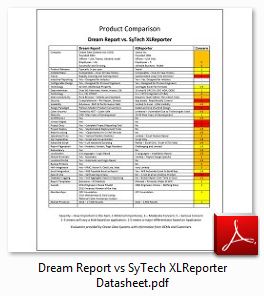There are alternative Report Generation solutions on the market. Some solutions are based on technologies designed for business, re-purposed for use in industrial applications. Some are purpose built specifically and completely for industrial applications. And some are a mix, the combination of a useful business tool, with automation that makes it more applicable to industrial applications. Microsoft SQL Server Reporting Services and SAP Crystal Reports are examples of the first type. Dream Report is an example of the second. SyTech XLReporter is an example of the third solution.
SyTech XLReporter does offer connectivity to industrial data sources, and it offers the ability to automate the addition of data to an Excel Workbook. In some cases, this requires an instance of Excel to be present, in other cases, XLReporter can operate without a licensed copy of Excel, by manipulating an Excel Workbook directly. In the end however, data is stored in an Excel Workbook as the final formatting environment. This brings with it both strengths and weaknesses. On the strength side, you have the power of Excel, with all its formatting and computation strengths through scripting and VSTO. On the negative, scalability can be an issue, and users need to be proficient in the intricacies of Excel to format the report to their exact needs.
The automation of Excel has been a popular way of generating reports. With the early introduction of DDE (Dynamic Data Exchange), Excel was able to extract information from a wide variety of industrial data sources. Over time, this connectivity was enhanced to leverage newer technologies like OPC, or techniques to insert data directly into an Excel Workbook through Excel APIs or third party tools to manipulate Excel Workbooks directly. In the end, it is an Excel Workbook that these applications are working with, including the limitations and vulnerabilities. These limitations are even more pronounced in regulated industries where reporting is extremely important. There are additional requirements for scalability, performance, electronic signatures, version management, redundancy, or web accessibility that are challenging to address with a two technology solution that isn’t completely optimized for use in Industry.
Dream Report makes reporting easy, by intelligently delivering the analysis a user needs, and supporting those analytics with associated presentation objects. If you wish to calculate an Overall Equipment Effectiveness (OEE) over a series of data, you simply select the data set, and specify an OEE result. The rest is automatic. If you are interested in a data query with the high value, time of high, low value, time of low, etc., those are all predefined analytics to apply and display as a Table object. There is no need to perform Excel gymnastics to reach your result. Pagination, object scaling with variable data sets, page numbering and titles are all automatic and trivial to apply within Dream Report.
If Excel is a format that you must support, Dream Report will deliver that as well. An Excel file format, or PDF, and HTML are all output formats that can be selected in a Dream Report application.
For more information on the differences between Dream Report and SyTech XLReporter, Please Contact Us for a more detailed evaluation.

Note – With any product or company evaluation, results may be biased, based on old information, or inaccurate due to misinterpretations. Your mileage will vary. Please use this information as a guide to areas of investigation. Please do your own evaluation, based on the specific needs of your application to determine the product that is best for you. Ocean Data Systems is open to assisting with product evaluations for specific applications. Please don’t hesitate to contact us.

